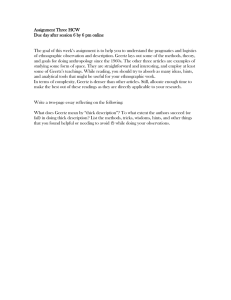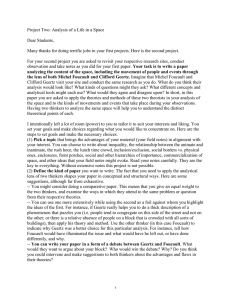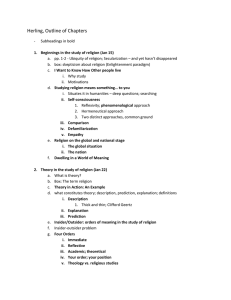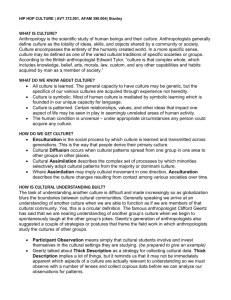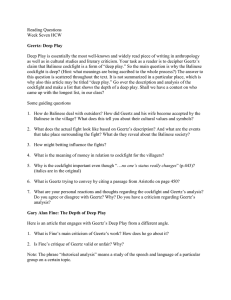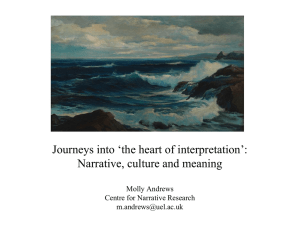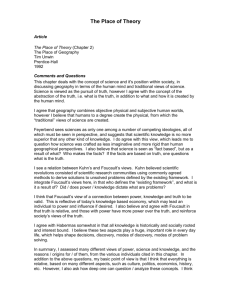HCW Handout on Clifford Geertz and Michel Foucault Dear Students,
advertisement
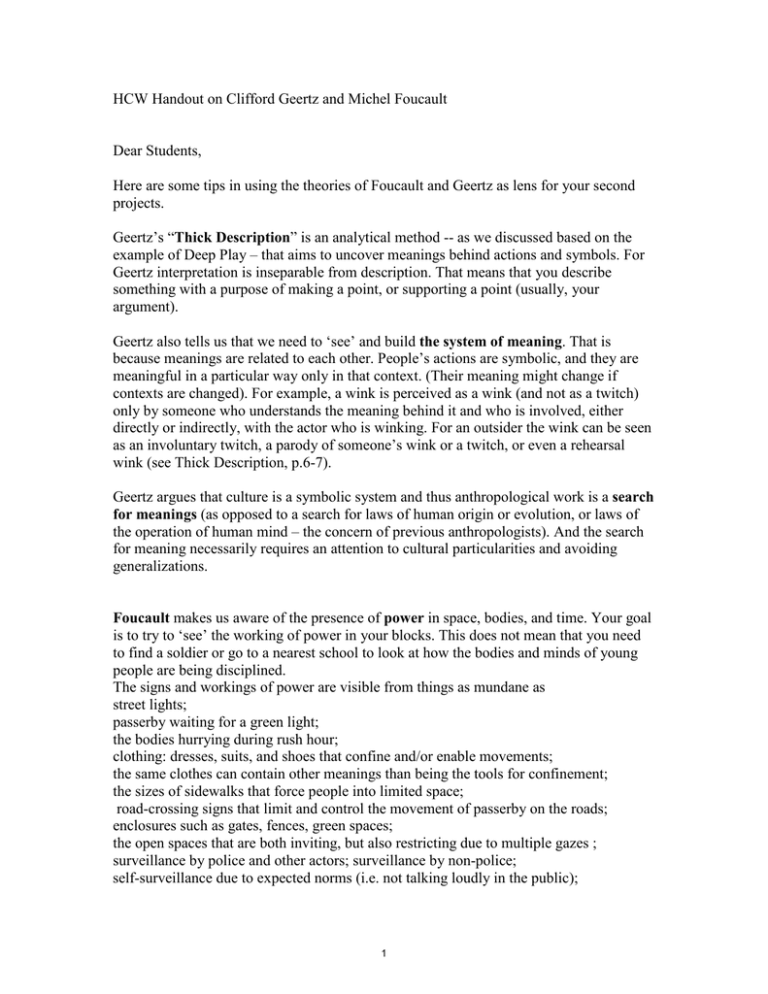
HCW Handout on Clifford Geertz and Michel Foucault Dear Students, Here are some tips in using the theories of Foucault and Geertz as lens for your second projects. Geertz’s “Thick Description” is an analytical method -- as we discussed based on the example of Deep Play – that aims to uncover meanings behind actions and symbols. For Geertz interpretation is inseparable from description. That means that you describe something with a purpose of making a point, or supporting a point (usually, your argument). Geertz also tells us that we need to ‘see’ and build the system of meaning. That is because meanings are related to each other. People’s actions are symbolic, and they are meaningful in a particular way only in that context. (Their meaning might change if contexts are changed). For example, a wink is perceived as a wink (and not as a twitch) only by someone who understands the meaning behind it and who is involved, either directly or indirectly, with the actor who is winking. For an outsider the wink can be seen as an involuntary twitch, a parody of someone’s wink or a twitch, or even a rehearsal wink (see Thick Description, p.6-7). Geertz argues that culture is a symbolic system and thus anthropological work is a search for meanings (as opposed to a search for laws of human origin or evolution, or laws of the operation of human mind – the concern of previous anthropologists). And the search for meaning necessarily requires an attention to cultural particularities and avoiding generalizations. Foucault makes us aware of the presence of power in space, bodies, and time. Your goal is to try to ‘see’ the working of power in your blocks. This does not mean that you need to find a soldier or go to a nearest school to look at how the bodies and minds of young people are being disciplined. The signs and workings of power are visible from things as mundane as street lights; passerby waiting for a green light; the bodies hurrying during rush hour; clothing: dresses, suits, and shoes that confine and/or enable movements; the same clothes can contain other meanings than being the tools for confinement; the sizes of sidewalks that force people into limited space; road-crossing signs that limit and control the movement of passerby on the roads; enclosures such as gates, fences, green spaces; the open spaces that are both inviting, but also restricting due to multiple gazes ; surveillance by police and other actors; surveillance by non-police; self-surveillance due to expected norms (i.e. not talking loudly in the public); 1 group exclusion and inclusion; lightning and a lack of it; lists of names for registration (any registration); a map of a city a map of a transportation route (who is being controlled here?) documentation about one’s class attendance; illness history in hospital file; grading; etc. Remember, power does not have to be presented to you obviously, like a brutal execution, or a police officer declaring a traffic rule in a middle of the street. In fact, Foucault argues that the distinct feature of modern power is its invisibility. Power, as we learned, is a force that enables a particular kind of behavior. And it might be prevalent in places that we least expect them. Both Geertz and Foucault essentially teach us to look deeper at the things that you observe and to rethink things that we might take for granted. Remember an important rule: a social and cultural phenomenon is a complex thing. One theory does not explain anything in its entirety. That is why you might need to combine both Geertz and Foucault (at least to some extent), and most likely you will also need some help from other readings to make a fuller sense of your observations and notes. That is why I suggested that you use two additional readings in addition to Foucault and Geertz. Finally, here are some terminologies that you might find make use of in your papers Agency Transgressions Public vs. Private Space Representation Oppression Domination Self-representation Democratization Inequality 2 Center vs. Periphery Social Movements Cultural Production Everyday life Circulation of signs Mass consumption Mass demonstrations (political and not political) Power Body Enclosures Time, time table Movement Graffiti Clothing Social construction Spatial divisions Panopticon Panopticism Institutions Visibility vs. invisibility Panoptic establishment Laboratory of power Social forces 3 Context (historical, local, national, regional) Disciplinary mechanisms State control Mechanisms of discipline 4 MIT OpenCourseWare http://ocw.mit.edu 21A.01 How Culture Works Fall 2012 For information about citing these materials or our Terms of Use, visit: http://ocw.mit.edu/terms.
